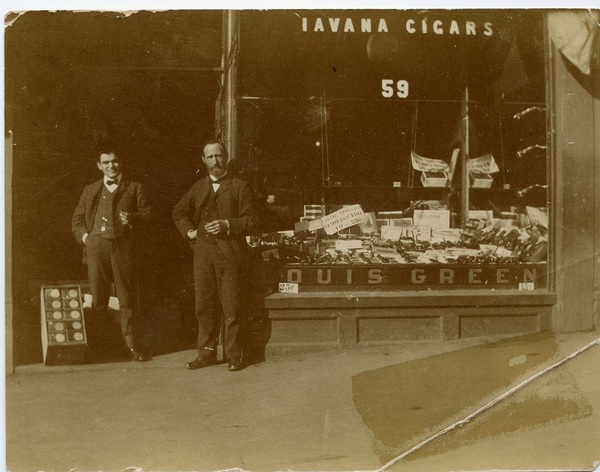
Source: Link
GREEN, NATHAN, cigar maker and merchant; b. 12 June 1828 in Amsterdam; m. first Elizabeth Pizarro (d. 20 Oct. 1853), and they had one son; m. secondly Jane Hart (d. 17 Oct. 1889) in New York City, and they had two sons and three daughters; d. 26 April 1922 in Chicago.
Nathan Green moved to London in 1842 and learned the cigar-making trade with Moses Gompers. He then left for New York in the 1850s with his brothers-in-law Solomon Henry Hart and Henry Levy. England offered few opportunities for immigrant Jews; journeying to the New World opened up better prospects. While in New York, Green worked with and befriended fellow cigar maker Samuel Gompers, a relative of Moses’s and later the founder of the American Federation of Labor.
By 1859 Green was living with his wife and children in Saint John, as the second Jewish family to make this city its home. They had been preceded by Solomon Hart and his wife Alice Catharine Davis*, who had settled with their family in 1858; Henry Levy also resided in the city for a few years. Green’s household in 1871 included his wife, six children, a female domestic servant, and a male apprentice. His home was imposing and had a billiard room. Until 1878 Green was one of a small Jewish community in Saint John that numbered no more than 15. In 1879 he participated in the first Rosh Hashana and Yom Kippur services held in the city. The second celebration almost did not happen: the minyan, or quorum, for public worship was ten males over the age of 13 but the community was one short until a Jewish visitor was located in a city hotel. Three years later the first Jewish wedding in the Maritime provinces was celebrated when Green’s eldest son, Louis, married the Harts’ daughter Elizabeth; they would become the parents of Solomon Hart Green*, a lawyer and mla in Manitoba. The first Jewish burial in Saint John had occurred in 1873 after Nathan Green and others had purchased a plot of land for a cemetery (the remains of deceased members of the community had generally been conveyed to New York for interment). The burial ground was consecrated by a rabbi from Boston. The plot retains the name Green-Hart Cemetery and is the burial ground for the original settlers and their descendants.
Green’s life in Saint John revolved around the cigar-manufacturing and wholesale and retail tobacco business he had established in 1861, the largest in the city. His home and store, located on Prince William Street, were destroyed in the great fire of 20–21 June 1877 [see Sylvester Zobieski Earle*], but he was reportedly back in business within 24 hours. Advertisements for his store indicated a wide range of merchandise for which he was the exclusive distributor. Those who approached it after 1880 were greeted by a carving of a Scotsman which stood on the street outside.
The first Jew in the Maritimes to belong to the masonic order, Green was listed as a member of St John’s Lodge No.2 for many years and was at his death its oldest living member. He was also a philanthropist, known especially for his assistance to the county poorhouse and to impoverished immigrants arriving in the city. He was the last Saint John resident to receive the freedom of the city before confederation. This was a privilege paid for by those who intended to conduct business there and was recorded in the city’s financial accounts as a form of business taxation.
In 1888, at the age of 59, Green disposed of the stock in his tobacco shop, then located on Charlotte Street, and retired with savings of $100,000. Believing that this sum would last him for the rest of his life, he moved with his wife, his son Solomon, and his daughters Sarah and Frances to Chicago, where members of the family were already established. The Greens’ son Henry (Harry) had settled there in 1885 and had established a wholesale and retail tobacco business. Their daughter Elizabeth had married a Chicago resident in 1886 and two of Green’s sisters were also living in the city. Green purchased a block of houses for himself and his family; there he resided for many years, first with his wife and after her death in 1889 with one of his daughters. For a time he was associated with Harry Green and Company, in which Solomon had become a partner. Despite the distance, he maintained close ties to the Jewish community in Saint John. His son Louis, who had remained in the city, annually purchased a train ticket for his father to visit. In 1899 Nathan sponsored two small prizes for the Saint John Hebrew School. Six years earlier he had hosted a reception for the City Cornet Band of Saint John, which performed at the Columbian exposition in Chicago. Green boasted of his love of travel and made the voyage across the Atlantic more than 70 times.
Nathan Green died in his sleep in Chicago, at the age of 93.
Fernhill Cemetery Company (Saint John), Burial records. LAC, RG 31, C1, 1871, Saint John County (mfm. at Saint John Regional Library). Saint John Jewish Hist. Museum Arch., Corr. from Richard Berger, 21 June 1988; Green–Hart–Isaacs family tree, comp. Phyllis Green (1976); Hart–Green family tree; Hist. of Jewish businesses, Saint John City directory, 1880–1989; Shaarei Zedek Cemetery database; Joseph Tanzman, “The story of the Jewish community of Saint John, N.B.” (typescript, n.d.). Saint John Regional Library, Misc. index, SB (scrapbook) 18 (mfm.). Jewish Times (Montreal), 7 July, 22 Dec. 1899. St. John Daily Sun, 30 Sept. 1893. St. John Daily Telegraph and Morning Journal, 1 May 1871; continued as Daily Telegraph, 28 Sept. 1881, 16 Dec. 1896, and as Telegraph-Journal, 28 April 1926, 3 Feb. 1966. Saint John Globe, 11 Oct. 1882, 1903–13. Eli Boyaner, “The settlement and development of the Jewish community of Saint John,” N.B. Hist. Soc., Coll.(Saint John), no.15 (1959): 79–86. Directory, Saint John, 1865/66–89/90. Grand Lodge of the Ancient and Honorable Fraternity of Free and Accepted Masons of N.B., Proc. (Saint John), 1868–88. The Jew in Canada: a complete record of Canadian Jewry from the days of the French régime to the present time, ed. A. D. Hart (Toronto and Montreal, 1926). Marcia Koven, Weaving the past into the present: a glimpse into the 130 year history of the Saint John Jewish community (Saint John, 1989). The Lakeside annual directory of the city of Chicago (Chicago), 1888–90. Sheva Medjuck, Jews of Atlantic Canada (St John’s, 1986). S. E. Rosenberg, The Jewish community in Canada (2v., Toronto and Montreal, 1970–71), 1. Vital statistics from N.B. newspapers (Johnson), 27–83.
Cite This Article
Katherine N. E. Biggs-Craft, “GREEN, NATHAN,” in Dictionary of Canadian Biography, vol. 15, University of Toronto/Université Laval, 2003–, accessed January 19, 2026, https://www.biographi.ca/en/bio/green_nathan_15E.html.
The citation above shows the format for footnotes and endnotes according to the Chicago manual of style (16th edition). Information to be used in other citation formats:
| Permalink: | https://www.biographi.ca/en/bio/green_nathan_15E.html |
| Author of Article: | Katherine N. E. Biggs-Craft |
| Title of Article: | GREEN, NATHAN |
| Publication Name: | Dictionary of Canadian Biography, vol. 15 |
| Publisher: | University of Toronto/Université Laval |
| Year of publication: | 2005 |
| Year of revision: | 2005 |
| Access Date: | January 19, 2026 |




